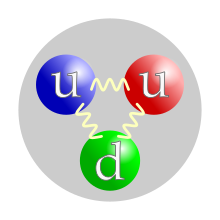
Back Subatomiese deeltjie Afrikaans جسيم دون ذري Arabic فرتيتة تحتدرية ARY Partícula subatómica AST Maddə və sahə zərrəcikləri Azerbaijani آتوم پارچاجیقلاری AZB Субатамная часціца Byelorussian Субатомни частици Bulgarian सबएटॉमिक पार्टिकल Bihari অতিপারমাণবিক কণা Bengali/Bangla

In physics, a subatomic particle is a particle smaller than an atom.[1] According to the Standard Model of particle physics, a subatomic particle can be either a composite particle, which is composed of other particles (for example, a baryon, like a proton or a neutron, composed of three quarks; or a meson, composed of two quarks), or an elementary particle, which is not composed of other particles (for example, quarks; or electrons, muons, and tau particles, which are called leptons).[2] Particle physics and nuclear physics study these particles and how they interact.[3] Most force carrying particles like photons or gluons are called bosons and, although they have discrete quanta of energy, do not have rest mass or discrete diameters (other than pure energy wavelength) and are unlike the former particles that have rest mass and cannot overlap or combine which are called fermions.
Experiments show that light could behave like a stream of particles (called photons) as well as exhibiting wave-like properties. This led to the concept of wave–particle duality to reflect that quantum-scale particles behave both like particles and like waves; they are sometimes called wavicles to reflect this.[4]
Another concept, the uncertainty principle, states that some of their properties taken together, such as their simultaneous position and momentum, cannot be measured exactly.[5] The wave–particle duality has been shown to apply not only to photons but to more massive particles as well.[6]
Interactions of particles in the framework of quantum field theory are understood as creation and annihilation of quanta of corresponding fundamental interactions. This blends particle physics with field theory.
Even among particle physicists, the exact definition of a particle has diverse descriptions. These professional attempts at the definition of a particle include:[7]
- A particle is a collapsed wave function
- A particle is a quantum excitation of a field
- A particle is an irreducible representation of the Poincaré group
- A particle is an observed thing
| Subatomic particle | Symbol | Type | Location in atom | Charge (e) |
Mass (u) |
|---|---|---|---|---|---|
| Proton | p+ | Composite | Nucleus | +1 | ≈1 |
| Neutron | n0 | Composite | Nucleus | 0 | ≈1 |
| Electron | e− | Elementary | Shells | −1 | ≈1⁄2000 |
- ^ "Subatomic particles". NTD. Archived from the original on 16 February 2014. Retrieved 5 June 2012.
- ^ Bolonkin, Alexander (2011). Universe, Human Immortality and Future Human Evaluation. Elsevier. p. 25. ISBN 9780124158016.
- ^ Fritzsch, Harald (2005). Elementary Particles. World Scientific. pp. 11–20. ISBN 978-981-256-141-1.
- ^ Hunter, Geoffrey; Wadlinger, Robert L. P. (August 23, 1987). Honig, William M.; Kraft, David W.; Panarella, Emilio (eds.). Quantum Uncertainties: Recent and Future Experiments and Interpretations. Springer US. pp. 331–343. doi:10.1007/978-1-4684-5386-7_18 – via Springer Link.
The finite-field model of the photon is both a particle and a wave, and hence we refer to it by Eddington's name "wavicle".
- ^ Heisenberg, W. (1927), "Über den anschaulichen Inhalt der quantentheoretischen Kinematik und Mechanik", Zeitschrift für Physik (in German), 43 (3–4): 172–198, Bibcode:1927ZPhy...43..172H, doi:10.1007/BF01397280, S2CID 122763326.
- ^ Arndt, Markus; Nairz, Olaf; Vos-Andreae, Julian; Keller, Claudia; Van Der Zouw, Gerbrand; Zeilinger, Anton (2000). "Wave-particle duality of C60 molecules". Nature. 401 (6754): 680–682. Bibcode:1999Natur.401..680A. doi:10.1038/44348. PMID 18494170. S2CID 4424892.
- ^ "What is a Particle?". 12 November 2020.
© MMXXIII Rich X Search. We shall prevail. All rights reserved. Rich X Search